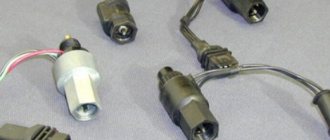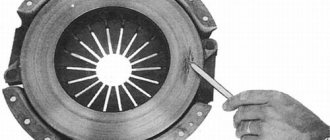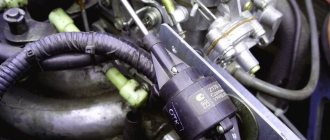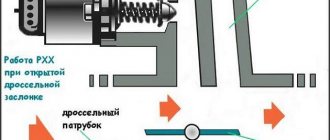The main signs of a malfunction of the mass air flow sensor (another name is a flow meter, mass air flow sensor, MAF-sensor) - increased fuel consumption, interruptions in engine operation (loss of power, floating speed, stalls at idle, hard to start when cold) and other similar symptoms of a malfunction Therefore, this sensor is also checked in parallel.
To find out exactly what the reason is, a comprehensive diagnosis of the car is carried out using a scanner (tester) or a random check of sensors, including a flow meter, a multimeter (voltmeter) and other methods. We will discuss these and other points further.
What is he responsible for?
The MAF sensor plays an important role in forming the correct air-fuel mixture. The sensor constantly monitors the volume of air passing through the intake system and transmits the received data to the ECU.
The latter, having received information from the flow meter and other sensors, forms a fuel-air mixture that guarantees engine operation at optimal speeds with minimal fuel consumption.
Other sensors can also correct the MAF readings: atmospheric pressure and air temperature, but they are not installed on all cars.
If the MAF sensor is broken, then the volume of incoming air is determined by the controller based on the angle of the throttle valve. This does not ensure economical operation of the engine, but the car drives.
Why do you need a mass air flow sensor?
The photo shows the mass air flow sensor. It is always located at the outlet of the air filter
As already mentioned, the main task of the mass air flow sensor is to inform the ECU about how much air is currently passing into the combustion chambers of the car’s power unit. This information is important because, unlike a carburetor engine, in which the working mixture is created by the carburetor, an injection engine creates the mixture in the cylinders. The air in the injector is sucked into the cylinders by vacuum, and gasoline is injected by injectors.
Each injection is strictly dosed, and the supply of fuel is controlled electronically based on information received from the sensors. The fuel dose depends on the position of the crankshaft, the speed at which it rotates, the throttle position, and the amount of air entering the cylinders. The DMVR sensor helps the ECU balance the fuel mixture and thereby ensure optimal engine operation under given conditions.
Types and principle of operation of flow meters
The mass air flow sensor is a hot-wire device.
The main types that are used on cars:
- Film with analog and digital signal.
- Wire (thread) analog.
- Frequency mass air flow sensor. Already installed on most modern cars coming off the assembly line.
Pitot tube (vane type) flowmeters are not considered due to their outdated design.
The operating principle of the first two types of devices is similar to each other and is based on changing the voltage readings supplied to the heating elements (threads or film). The ECU monitors these changes and performs calculations to form the fuel-air mixture. More details below.
Wire mass air flow sensor
Used on most modern cars. In such devices, the key role is played by thermistors - two tungsten or platinum filaments with a diameter of 0.07 mm, to which voltage is applied with a certain current strength, as a result they heat up, as well as a thermistor (temperature sensor), but it is not provided everywhere.
One thread is closed from the air flow, and the second, with the throttle valve open, on the contrary, is blown and actively cooled.
To equalize the temperature readings of thermistors, more current is supplied to the open thread.
The ECU takes into account the difference in voltage readings between the threads, the intensity of their cooling and, based on them, calculates the volume of incoming air and, in accordance with this, calculates the required amount of fuel supplied to the cylinders.
Wire mass air flow sensors have several significant disadvantages: over time they become dirty or wear out.
To solve the first problem, the designers developed a self-cleaning mode. It provides for short-term (so as not to discharge the battery) heating of the filament to 1000-11000C with the engine turned off. At this temperature, all deposits burn out.
When the thermistors wear out, the sensor is replaced.
Film flowmeters
Structurally, such sensors differ from the first ones, although the principle of their operation is largely the same.
Instead of a sensitive thread thermistor, a platinum-coated ceramic heating element or semiconductor film is installed here.
The location of the film device remains the same, and the ceramic element itself has several resistor layers, each of which performs its own function: a temperature sensor, a heating one, two thermistors.
An important advantage of such a sensor is that it measures the temperature of not only the incoming air, but also the reflecting air. The device is also less susceptible to contamination.
It is worth noting that in modern devices, the output signal U is transmitted not only in analog mode, but also in digital mode, this speeds up data processing.
Frequency mass air flow sensor
The General Motors product was installed on the first VAZ 2109 and worked in tandem with the January 4 ECU. It is characterized by reliability and a long service life.
The principle of operation is not based on a change in direct voltage, but on a change in the frequency of the output signal of an alternating signal U. When the frequency is high, this indicates high air flow, low frequency indicates low air flow.
The main advantage of a frequency flow meter is stable data transmission to the ECU when the voltage in the circuit drops (poor contact, oxidation, etc.).
Let's imagine that the contacts in the connectors have oxidized. Then the output signal of 1.02V will decrease and, for example, 0.9V will come to the controller. This is not critical, but it will increase fuel consumption.
In the frequency sensor, voltage surges do not affect the operation of the ECU in any way. Oxidation of the contacts will not change the signal frequency in any way, which means 100% of the output data will reach the recipient, i.e. controller (ECU).
How to check the mass air flow sensor with a multimeter and more
The engine of any car operates in a variety of modes. Each of them requires an individual ratio of gasoline and air. It is to create this mixture that the mass air flow sensor is designed. Today you will learn how to check, but first, we will analyze its principle of operation and design in order to clearly understand what you have to do.
The sensor itself is mounted in the space between the air filter and its pipe. It consists of a wire stretched along the entire perimeter of the air channel, both ends of which are connected to the vehicle’s on-board network. The meaning of its operation is that a certain voltage is applied to it and the flowing current heats the wire.
The air flow passing through the pipe cools the wire and its resistance changes, and the output voltage changes accordingly. Moreover, this value depends on the amount of incoming air. Thus, the sensor sends a signal to the ECU and it performs all the necessary calculations to maintain the stoichiometric ratio of gasoline and air.
Diagnostics of DMRV faults
Having understood the principle of operation, it’s time to find out how to check the operation of the sensor. Prerequisites for malfunctions of the mass air flow sensor include the following symptoms:
- The first and most important sign is the engine switching to emergency mode . The “Check Engine” indicator lights up on the instrument panel. This happens because the sensor stops sending the information needed by the controller to supply the required mixture, so it switches the injector to “carburetor” mode when the mixture is supplied in a strictly specified quantity.
- Unstable engine operation when using the XX mode.
- High or too low revolutions of the same idle speed. One of the resulting emergency engine operation.
- Difficulty starting the engine. In some cases, the engine does not start at all.
- Bad dynamics . Many drivers call this behavior of the car “stupid” acceleration.
- High fuel consumption also comes from the emergency mode of the engine.
Now that you have dealt with the signs of a malfunction, it’s time to open the hood and start checking the sensor. There are enough ways to find out about its condition and anyone, even a novice driver, can handle it.
1. Disable the sensor. As you may have guessed, the sensor no longer sends information about the amount of air and the computer will 100% switch the engine to emergency mode. Try starting the engine and driving the car.
If the dynamics have improved, and the idle speed is around 1500 rpm. This means the sensor is faulty. This method is suitable for those whose motor, with the sensor turned on, went into emergency operation mode, and therefore is not widely used.
More typical for older fuel-injected cars.
2. Controller firmware. If you have recently been flashing your ECU, it is likely that the software did not install correctly.
In this case, you can put a plate no more than 1 mm thick under the damper. Start the engine, the speed should be within 1500 rpm.
After this, try to disable the sensor chip and if the motor does not change its operation, then the reason is 100% in the firmware.
3. Professional way. Involves the use of a multimeter and gives accurate measurement results. You can measure both the resistance and the voltage on the sensor wire, but a more accurate measurement is obtained in the second case.
To do this, set the voltmeter switch to the 12 Volt DC position and attach the probes to the ends of the sensor. In this case, you can get the following results:
— 1.01-1.02 - this means that the sensor is working and does not need to be replaced. The reason for this engine behavior must be sought elsewhere.
What does the malfunction lead to?
It cannot be said that a breakdown of the flow meter will immediately lead to critical consequences, but if you ignore the problem, then prolonged operation of the engine on an incorrectly formed fuel-air mixture will lead to rapid wear of the elements of the cylinder-piston group, and when several factors overlap, detonation in the engine and even its “wedge” can occur. .
For example, if a rich mixture enters the engine, the engine will quickly overheat as a result of oil dilution.
Also, a faulty MAF sensor, due to deterioration in exhaust purity, significantly affects the reduction of the service life of the catalytic converter, particulate filter and exhaust system as a whole.
Signs of malfunction of the DMVR
As is already clear from the above material, if the mass air flow sensor is faulty, the ECU forms a fuel-air mixture without maintaining the correct proportion. For example, you need 1:14, and the mixture will enter the cylinders in a ratio of 1:15 (lean) or 1:13 (rich). And at a ratio of 1:5 the mixture does not ignite at all.
As a result, a breakdown of the flow meter may manifest itself with the following symptoms:
- Difficulty starting the engine (especially in cold weather).
- Increased fuel consumption.
- Floating speed at idle, the car stalls. At the same time, this may not happen on a cold engine, but as soon as the engine warms up, the speed jumps from 1000 to 1600 per minute.
- The engine does not pull, acceleration dynamics have disappeared.
- The car drives jerkily.
- The car stalls when upshifting or downshifting.
- The "Check Engine" light comes on and does not go out.
- Rapid overheating of the motor.
It is important to understand that all these signs do not specifically indicate a malfunction of the MAF sensor and here you need to take a comprehensive approach to finding the causes of the failure and use different diagnostic methods.
How to check the mass air flow sensor (MAF)
The main symptoms of a malfunctioning mass air flow sensor:
- Check Engine light comes on,
- vehicle fuel consumption increases,
- it is difficult to start the engine “hot”,
- dynamics disappeared, acceleration became slower,
- The engine power dropped noticeably.
There are several basic ways to check the operation of the mass air flow sensor (MAF).
Disabling the mass air flow sensor
Disconnect the sensor connector and start the engine. When the mass air flow sensor is disconnected, the controller goes into emergency mode, and the fuel mixture is prepared solely based on the throttle position. Engine speed must be greater than 1500 rpm.
If during a test drive the car began to behave more cheerfully, then we can conclude that the mass air flow sensor is not working.
Alternative ECU firmware
The standard firmware of the controller could be replaced by any other, in which case for emergency mode (the one discussed in the first method), anything can be “written” in it.
Slide a plate approximately 1 mm thick under the damper stop. The engine speed should rise. After this, pull out the chip from the mass air flow sensor. If the car does not stall, then there is a problem with the firmware.
Or rather, with the steps of the idle air control when operating in emergency mode without a mass air flow sensor.
Causes of failure
Here we list the main reasons why the mass air flow sensor fails or does not work correctly:
- Burnout (burst) of the thermistor or damage to the coating on the tracks. This disease is especially typical for the HFM-5 sensor model. This can happen as a result of natural wear and tear or a sudden surge in voltage in the network (the generator has failed, etc.). On average, wire devices last about 150 thousand car miles.
- Lack of voltage – break in the signal or operating electrical circuit, the sensor is not connected, oxidation of the contacts.
- The ECU has failed.
- Incorrect maintenance. The flow meter is considered a maintenance-free device and can be replaced as an assembly. But since it is expensive, many try to clean it, for example, with cotton wool, which is wrong. To do this, use compressed air or special liquids (carbocleaner, special air flow sensor cleaner or other alcohol-based product).
Indirect reasons:
- The throttle valve is jammed as a result of its contamination - in this case, the sensor seems to be working, but the information is not transmitted to the ECU correctly.
- The air filter is clogged.
Signs of a DMRV malfunction:
- Rough engine idle.
- Deterioration of acceleration dynamics - “stupid acceleration”.
- Idle speed too high or low.
- Increased fuel consumption.
- The engine does not start.
However, we cannot exclude other reasons why the mass air flow sensor may not work. For example, if the hose connecting the flow meter to the throttle module is cracked, the sensor wiring is damaged, or there are other problems with the power supply to the mass air flow sensor,
may look like it's faulty.
How to quickly determine that the sensor is faulty?
To quickly check the mass air flow sensor for functionality, do the following:
- Start the car and warm up the engine to operating temperature (up to 80 degrees is possible). To speed up the process, increase the speed periodically.
- Turn off the car.
- Disconnect the terminal from the sensor.
- Start again without pressing the gas pedal.
- If the engine begins to sharply gain speed, which is not typical for idling, then, on the contrary, goes to the bottom, then the air flow meter is faulty.
How to check frequency-type air flow sensor
Let's look at the example of Citroen Peugeot 1.6 HDI diesel. A similar four-wire MAF sensor is found on the models shown below.
To check, you will need a diagnostic scanner or multimeter that supports this function.
Sensor pinout:
- Intake temperature sensor output signal.
- Weight.
- Not involved.
- On-board voltage +12V.
- Frequency signal from the sensor.
Connect:
- Second Pin – “ground”
- The fifth Pin is the output signal.
At rest with the ignition on, the output frequency should be 5 kHz.
After starting the engine at idle, the frequency should decrease and vary from 1.02 to 3.3 kHz. For each frequency mass air flow sensor frequency table.
Features of testing for Ford Focus 2
In most cases, for foreign cars, the flow meter diagnostic methods are similar, but they still have their own characteristics. It all depends on the car model and the brand of the installed MAF sensor.
For example, on Ford Focus 2 there are sensors with four or six wires. Original product FORD 1072308.
The pinout is shown below using an example of a 4-wire sensor.
- A – voltage 12V.
- B – “–” (mass).
- C – “–” reverse earth (literal translation).
- D – output signal SIG to the ECU.
Two additional wires are connected to the 6-pin sensors: IAT (intake air temperature) sensors.
To check the mass air flow sensor on a Ford Focus 2, do the following:
- Disconnect the connector from the flow meter.
- Turn on the ignition.
- Connect the “–” of the multimeter to “B” (ground) on the wiring harness (see the figure above).
- “+” of the device to positive “A” (12V).
The multimeter should show 12V. If not, then we look for the reason why the sensor does not receive U.
Next steps (you will need an assistant):
- Plug the chip back in.
- Without turning off the ignition, using sharp multimeter probes, connect “+” (pierce the wire) to the signal “D”, and “–” to “C” (reverse ground). The norm is 0.9 – 1.0V.
- Ask an assistant to start the car, warm it up and set the speed to 1500. The device should show 1.4 - 1.6V. At 2500 rpm – 1.8 – 2.0V.
- With the gas pedal fully depressed (as the speed increases), the device should show from 0.2 to 5V.
The range of standard indicators is not indicated by chance. It will vary depending on engine size.
Also diagnose Ford Focus 2 with a scanner (read above). The standard air flow rate is 9–12 kg/h or about 2.8 g/s at idle speed.
How to check the mass air flow sensor for serviceability
There are several basic methods for checking the mass air flow sensor, which allow you to verify its malfunction.
Checking the mass air flow sensor in motion
The easiest way to diagnose a flow meter is to analyze the operation of the engine when the sensor is forcibly turned off. The check proceeds as follows:
It is necessary to open the hood and disconnect the connector from the mass air flow sensor. After this, close the hood; Next, get behind the wheel of the car and start the engine. The car should start to operate in limp mode, in which the Check Engine light will be on.
In such a situation, the amount of air in the fuel mixture will be determined depending on the throttle position; Try driving the car and pay attention to its dynamics in comparison with how the car worked before the mass air flow sensor was turned off. With the sensor turned off, the car should become “more lively”, that is, accelerate faster
If this is the case, then we can confidently talk about problems with the mass air flow sensor.
It is highly not recommended to operate a car for a long time with the mass air flow sensor turned off.
Checking the mass air flow sensor with a multimeter
You can diagnose a problem with the sensor using a multimeter. To do this, you must first understand the design of the device and its “pinout,” that is, the wiring of the wires on the board. There are 4 wires coming out of the mass air flow sensor. Depending on the MAF model and manufacturer, their colors may vary, but in most cases they are as follows:
- Pink (or pink-black): wire to main relay;
- Green: wire to ground;
- Gray: wire to power;
- Yellow: signal input.
To check the mass air flow sensor, the multimeter must be set to constant voltage measurement mode and set the limit to 2 Volts. Next, you need to turn on the ignition, but do not start the engine. Once this is done, connect the multimeter's red lead to the sensor's signal input (yellow wire) and the black lead to ground (green wire). This can be done without “exposing” the wires by inserting the probes of the diagnostic device through the rubber seal of the connector.
Based on the measurement results, conclusions can be drawn about the state of the sensor:
- Fully serviceable device (new): 0.996 - 1.01 Volts;
- The sensor is in good condition, but has already worked: 1.01 - 1.02 Volts;
- The sensor has been working for a long time, but is still working: 1.02 - 1.03 Volts;
- The mass air flow sensor will soon need to be replaced: 1-03 - 1.04 Volts;
- The flow meter is close to failure, but continues to cope with the tasks: 1.04 - 1.05 Volts;
- The sensor needs to be changed: 1.05 Volts and above.
Some modern on-board computers allow you to view the voltage on the mass air flow sensor. In such situations, you can do without a multimeter.
Visual inspection of the mass air flow sensor
Experienced motorists can determine a malfunction of the mass air flow sensor by its appearance. The first step is to remove the mass air flow sensor, and then inspect it carefully. Signs of a malfunction are liquid getting into the air pipe and the mass air flow sensor (or the presence of mechanical damage).
Most often, liquid may end up in the sensor for the following reasons:
- Increased oil level in the crankcase. In such a situation, oil enters the sensor;
- Clogged oil sump of the crankcase ventilation system;
- Untimely replacement of the air filter, due to which dirt gets onto the MAF hot air anemometer.
The easiest and most reliable way to diagnose problems with the mass air flow sensor is to replace it with a working device. For example, you can remove a suitable working sensor from another car, install it and make sure that engine operation has stabilized. In such a situation, you can immediately go buy a new sensor without diagnosing it with a multimeter or other methods.
(413 votes, average: 4.58 out of 5)
Loading…
Nissan Almera
Nissan Almera is equipped with mass air flow sensors from Hitachi, although you can also find products from Bosch. And you need to understand that the readings on devices from different manufacturers will differ.
To understand the process, we will make replacements on the Hitachi flow meter. Read above for the example of Bosch.
There are 5 wires going to the sensor. Measurements are taken first with the ignition on, then with the engine running. Prepare the multimeter by switching it to 20V mode.
Procedure:
- Insert a needle or pin into the third wire (pierce the insulation) on the air filter side.
- Turn on the ignition. “–” of the multimeter for battery ground, “+” for the needle. The norm is no more than 0.4V.
- Start the car and follow the steps in step 2. The norm is no more than 1.04V. Up to 1.05V is still respectable.
Flushing the sensor
Flushing the mass fuel flow sensor is a slippery topic. This helped some, while others, on the contrary, remained stuck with the “broken trough” - the flow meter completely failed.
The process itself is not complicated, disassemble (if the design allows) and clean the threads or film. If it is not possible to disassemble, use compressed air.
To wash the air flow sensor, special alcohol-based products are used.
Carburetor cleaners, solvents, and gasoline are used at your own risk. For some, the problem was solved, for others, the platinum coating was washed off.
Do not saw the product point-blank, but from a distance of 5–10 cm.
Design and location of the mass air flow sensor on VAZ cars
The mass air flow sensor is a small device installed on the pipe that connects the air filter and the throttle valve and serves to control the amount of air entering the VAZ engine.
Two platinum filaments are installed in the mass flow sensor housing, which heat up under the influence of electric current. When air passes through the sensor, it cools the first thread, the current resistance changes accordingly, the second thread is the control. Thus, the amount of air entering the injection engine of a VAZ car is assessed. The received data from the mass air flow sensor enters the electronic control unit (ECU), where the required ratio of air and fuel is calculated for the subsequent supply of the fuel mixture to the combustion chambers of the engine cylinders.
Purchasing a new and replacing the mass air flow sensor
Purchasing and replacing a mass air flow sensor is not a problem. The market is teeming with offers. Prices also vary from 2500 to 9000 rubles. For VAZ and GAZ, look for Bosch products with article number 0280218037.
To replace you will need:
- Cross-shaped or flat decoction.
- Key head 10 (for Lada Kalina).
Procedure:
- Loosen the air duct clamp bolt and move the latter to the side.
- Press the button under the plug and pull the latter out of the connector.
- Using a 10mm wrench, unscrew the two bolts (one on top, the other on bottom).
- Remove the sensor.
- Installation in reverse order.
1 of 3
— +
1.
2.
3.
Before buying a new flow meter, pay attention to the markings of the old one. It is advisable to purchase a product with the same marking so that it is guaranteed to be compatible with the car’s ECU.
The main thing after replacement is not to forget to adapt the new flow meter. To do this, remove the negative terminal of the battery for a few minutes to expose the data in the ECU.
In some car models, this cannot be done in a garage; you will have to go to a service center where there is special diagnostic equipment.
Recommendations for increasing service life
To extend the life of the MAF sensor, follow these recommendations:
- Change the air filter promptly to minimize clogging of the flow meter.
- Monitor the technical condition of the engine, carry out maintenance on time, change and fill only with high-quality engine oil.
- If the car has a high mileage, check the engine compression - wear or jamming of the piston rings and valve seals will lead to oil penetration into the intake system. This will prevent the appearance of oil deposits on the thermistors.
- Monitor the condition of the crankcase ventilation system. This is especially true for those engines where the crankcase gas suction pipe is connected in front of the mass air flow sensor. Check the condition of the oil separator under the valve cover.









